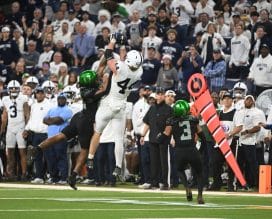Phillies
Branch Rickey and the Battle for Control over Baseball’s Integration Story
The story of Brooklyn Dodgers President Branch Rickey – the man who signed Jackie Robinson to break Organized Baseball’s longtime color line — leads inexorably to the widely accepted story of baseball’s integration, which Baseball celebrates today by patting itself on the back via Jackie Robinson Day. However, there can be more than one version of the tale. And in this instance, the well-worn Rickey story may very well have slowed the integration of baseball in Robinson’s wake rather than accelerated it. So while baseball congratulates itself once again, on the anniversary of the day it stopped doing what it should have never done in the first place, let’s take a moment to consider a man baseball seemingly can’t get enough of. No, not Jackie Robinson, but Branch Rickey.
What is beyond dispute is that Rickey was a baseball genius. His innovations throughout the course of his long career, spurred by his dual passions: his desire to obtain a competitive edge and his desire to do so as cheaply as possible, revolutionized the game. His development of the farm system while running the Cardinals in the 1930s blended both passions very neatly in that the system provided the Cardinals with a perennial treasure trove of potential talent available only to them and at bargain basement prices. This glut of talent forever on the doorstep of the Majors had the further benefit of driving down the salaries of Rickey’s big leaguers who were wary of engaging in pitched battles with him given the ever-looming threat of imminent replacement should they ever fall out of favor.
By 1943, however, when Rickey left the Cardinals to take over the reins of the Dodgers, the farm system no longer provided such a competitive edge due to the simple fact that Rickey had been so successful with it in St. Louis that by now many teams were at least rudimentarily following his lead. Although the Dodgers reached the World Series as recently as 1941, Rickey’s keen eye for talent recognized the reality that the team was an old one and on the verge of collapse. What was needed was an overhaul of the entire organization. The farm system would have to be rebuilt and restocked but that would only bring the organization so far. Rickey realized that in order for the Dodgers to outrun their competitors in the National League on the field, he would have to outsmart his adversaries in the talent acquisition game. The farm system no longer gave him a leg up; a rebuilt one would, at best, put him on equal footing with his rivals. What he needed was something different, some new source of talent untapped by anyone else.
Shortly after arriving in Brooklyn, Rickey received permission from the team’s directors to start scouting Black talent. Initially, Rickey had considered Latin American players but abandoned this idea due to the perceived obstacles faced by players who would have to overcome both a language as well as a racial barrier (although he would return to the Latin American talent pool later in his career with the Pirates). Once his focus became clear, Rickey was single-minded in his pursuit. “The greatest untapped reservoir of raw material in the history of the game is the Black race!” he said in 1945. In this regard, his pursuit satisfied his passion for a competitive edge. And, if he could convince the public that these talented Black players, currently being developed in the Negro leagues, were not under contract to their teams, they would be available to him virtually free of charge, thereby satisfying his frugal itch as well.
Although historically Rickey has been portrayed as a social reformer, in fact he was far from it, even by his own admission. Rather, he was a sharp baseball man with an eye on the bottom line whose baseball instincts just happened to run right smack into America’s burgeoning civil rights movement. Smart as he was (and no doubt much smarter than many of his baseball brethren), he recognized the rising tide and understood that baseball was going to have to integrate sooner rather than later – the symbolic status of the game made it such a convenient target for civil rights activists in the wake of World War II that it would have no choice. Rickey had increasingly felt these pressures firsthand – it was the heat generated by New York’s Quinn-Ives Act (signed into law in March 1945 and which imposed a fine of $500 or imprisonment for up to one year on any employer who refused to hire anyone because of their race) that boxed him into a corner just a few weeks later. On that morning, Joe Bostic — a reporter for the The People’s Voice, the Black weekly newspaper funded by Harlem Congressman Adam Clayton Powell, who a year earlier became the first African American New Yorker to be elected to Congress — arrived demanding a tryout for his players. Rickey had no choice but to grant them one, even though he had no intention of signing the players.
A few months later, as Rickey was working behind the scenes on his own integration plan, he learned that New York City mayor Fiorello LaGuardia was planning on making the integration of baseball the subject of his October 18, 1945 radio address. Combined with the LaGuardia-formed Committee for Unity’s pending statement calling for all three of New York’s teams – the Yankees, Dodgers and Giants – to integrate immediately so as to comply with Quinn-Ives, Rickey’s hand was forced. Unless he acted now, he would lose control of the integration issue and quite possibly his competitive edge as well. Therefore, he convinced LaGuardia to change the subject of his address and hastily announced the signing of Jackie Robinson to a minor league contract on October 23, 1945.
Faced with the impending reality, Rickey masterfully managed to maintain control over the situation: “The Negro will make us winners for years to come,” he said, once again in 1945. “And for that I will happily bear being a bleeding heart, and a do-gooder, and all that humanitarian rot.” In the midst of the moment, Rickey maintained that his was strictly a baseball decision. As the years passed, his story, as well as the official story, would morph into something different.
After the Robinson signing, Rickey began to emphasize reasons other than baseball for his actions. He became particularly fond of a story involving Charles “Tommy” Thomas, a black ballplayer Rickey coached at Ohio Wesleyan in 1903. According to the story, Thomas was refused hotel accommodations when the team traveled to South Bend, Indiana for a game. Rickey convinced the hotel clerk to allow Thomas to room with him. Once in the room, Thomas began to sob and, according to Rickey, scratch at his skin “as if he wanted to forcibly remove the stain of its color.” “I never felt so helpless in my life,” Rickey recalled later. In response, Rickey liked to say that he tried to reassure Thomas by telling him that “a time would come where there would be equal opportunity for all, regardless of race.” The story closes on a heartwarming, if dime novel, note as Rickey attempted to raise Thomas’ spirits: “Come on, Tommy, snap out of it, buck up! We’ll lick this one day, but we can’t if you feel sorry for yourself.”
The Thomas story was an inspirational one and one which certainly highlighted the humanitarian side of Branch Rickey, an apparent closeted civil rights advocate. However, it is one that was not told for the first time until shortly before Rickey signed Robinson, more than four decades from the date of its alleged occurrence. Although certainly Rickey and Thomas maintained a longstanding relationship that no doubt dated back to that time, and although it is likely that the story springs from a foundation of truth, the veracity of some of the specifics within it, particularly the most heart-wrenching ones, is open to question. In a court of law such testimony would likely be viewed with skepticism. As an American morality tale, it becomes fact simply because we would like for it to be. There is a difference between being sympathetic towards one’s plight and being a crusader for integration. Rickey was perhaps the former but boasted that he was the latter. Because his story fit a comforting narrative, however, few sought to question it.
As the years passed and Rickey’s legend grew, Rickey also stated that if it were up to him the Cardinals would have been integrated by the mid 1930’s; it was only club owner Sam Breadon who stood in his way. However, as with the Thomas story, no contemporaneous supporting evidence exists. He likewise claimed to have been a supporter of integration ever since the alleged 1903 Thomas incident but although he was an executive with significant input in player personnel decisions since becoming the general/field manager of the St. Louis Browns in 1913, he never once exhibited, at least publicly, any such indications prior to 1945.
Many decades later, his children and grandchildren helped to further burnish Rickey’s socially conscious image by recalling “stirring conversations at the Rickey dinner table… about Abraham Lincoln, the Civil War, and the unfortunate, continuing effects of slavery on American Negro life,” but with no corresponding, contemporaneous overt acts on Rickey’s behalf in the several decades in which he was a very public executive with the power to act or, at a minimum, speak out on behalf of these causes, it is difficult to ascertain how much of these such stories are fact and how much are rose-colored, sepia-toned family legend.
To many who have tried to tackle the Rickey story and legacy in print, he remains a conundrum: an arch-conservative civil rights pioneer who opposed what he termed “radicalism” in any form and in any manner save this one instance. He despised The Daily Worker, the newspaper published by Communist Party USA, as well as the agitation of the Black press even though both were aggressively lobbying for what he repeatedly claimed was a fervent cause of his since the 1903 Thomas incident. Later in life, even after the integration of baseball, he supported Barry Goldwater in 1964 rather than staunch civil rights advocate Lyndon Johnson. When questioned as to his political stance, Rickey replied that a vote for Johnson would be “a step toward national degradation.”
At every turn in his very public life, Rickey stood in the corner of the socially conservative with the exception of the Robinson matter. His actions in that one instance not only seem out of character but a direct contradiction to everything he believed in, and how he lived his life both before and afterwards. For his biographers, it is difficult to shoehorn the Robinson episode into Rickey’s life and still emerge with a coherent narrative. It is this riddle that causes many to throw up their hands and conclude simply that, in the end, Branch Rickey was a terribly complex man.
The possibility exists, however, that he was in fact quite simple and straightforward, at least in his actions if not always his words. Perhaps he simply wanted to win baseball games and was willing to take whatever avenue existed that enabled him to achieve this goal at the lowest possible cost. This simple narrative does not require the elaborate twists and turns that the Rickey story traditionally takes. However, this narrative is hardly a symbolic one, hardly one which stands in for both baseball and America at their best so it is not surprising that it is not as widely embraced. Rather, the “Rickey as racial pioneer” story took hold due to its obvious appeal, infused as it was with delicious didactic potential. Sometimes, however, a story is more than simply a story. In this instance, the Rickey story would have a damaging effect on the integration effort in multiple ways, ultimately and ironically slowing the pace of integration in Major League Baseball many years. Initially, it distracted from and negated the integration movement that had developed significant momentum independent of him. Eventually, it set the movement back decades. Arguably, the paucity of Black players in the modern game suggests that baseball is perhaps still feeling its effects.
Immediately, the story gave credence to longtime baseball commissioner and segregationist Kenesaw Mountain Landis’s longstanding lie that anybody within Organized Baseball could sign a Black player if they so chose. As such, it justified the falsehood and permitted white America to gloss over the reality of racism both within baseball and, more importantly, within the nation. Although Landis’s lie was a naked one, the Rickey story allowed Organized Baseball to escape greater scrutiny of its racist practices because it demonstrated that, at least superficially, Landis was correct. According to the Rickey story, one man did, after all, decide to sign a Black player and no one within the game stopped him. Baseball could defend itself by repeating the lie that the game was now, and always had been, open to everyone. It only took an individual with courage to make this possibility a reality. This fabrication glossed over the deep and longstanding institutionalized racism that was truly at the core of the issue, and which remained firmly entrenched despite Robinson's presence on a big league diamond.
More significantly, the story conveniently negated and ignored the enormous social pressures that the rising integration movement – spearheaded by the increasingly empowered and determined Black and alternative presses along with progressive governmental leaders such as LaGuardia and Adam Clayton Powell – had on Organized Baseball and which, in reality, had more to do with bringing the game to the brink of integration by the end of World War II than anything having to do with Branch Rickey. This, in turn, resulted in the tragic consequence of the story: it wrested the integration issue away from these people and put it in the hands of the baseball patriarchy — the very people who restricted the game for years — to be doled out on its terms and through its good graces.
The Branch Rickey story is a narrative heist that once again leaves the Black men and those in the alternative press who did the hard work to right an entrenched wrong on the sidelines, spectators to their own history. As baseball celebrates yet another Jackie Robinson Day it might be worthwhile to ask: whose story is it really celebrating?
This essay is adapted from A People's History of Baseball





